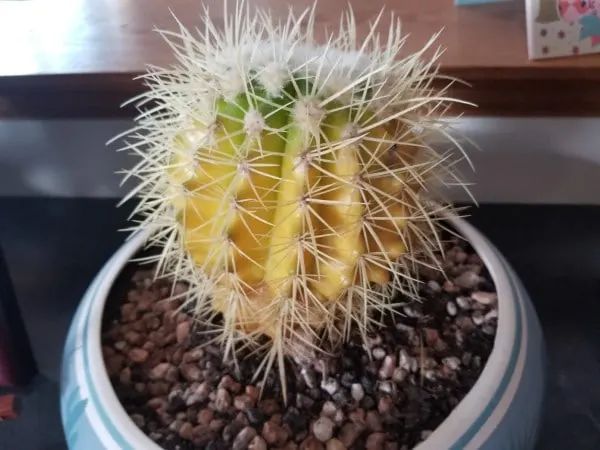When we think of cacti, we often envision vibrant greens against a parched backdrop, a resilient symbol of life thriving in desolation. However, when their verdant armor begins to betray them, taking on an unsettling yellowish hue, one must ponder: will a yellow cactus turn green again? Understanding the causes of this chromatic shift is essential for any cactus enthusiast or horticultural aficionado. Grasping the intricate provenance of yellowing cactus will provide invaluable insights into nurturing these seemingly invulnerable entities.
Why does a cactus, that steadfast sentinel of arid landscapes, transform from a luscious green to a disconcerting yellow? The answer encompasses a myriad of factors ranging from irrigation habits to environmental conditions and even diseases. Each yellowing cactus tells a story, often of neglect, improper care, or a miscalculated environment. Let us delve into these underlying causes to illuminate the path toward restoration.
The Intricate Dance of Sunlight and Shadows
Cacti are predominantly characterized by their affinity for sunlight. However, an ill-balanced relationship with it can lead to disastrous consequences. Insufficient light exposure can trigger a dramatic shift in color as the plant struggles to produce chlorophyll—a bio-pigment essential for photosynthesis. Conversely, excessive sunlight can scorch the cactus, leading to sunburn that manifests as yellowing. Understanding the light requirements of individual cactus species is paramount. A location that offers bright, indirect light, mimicking their native habitats, can help maintain their vibrant hue.
Overwatering: A Silent Assassin
Watering is an art form, particularly for cacti, which thrive in arid environments. The temptation to provide a yellowing cactus with more moisture can be counterproductive. Overwatering is a common blight among cactus caretakers, causing roots to rot—a fate akin to drowning. This condition can lead to nutrient deficiencies, resulting in yellow discoloration. Emphasizing a well-draining soil mix and a diligent watering schedule can rekindle the cactus’s vitality. When the soil dries out completely before the next watering, it mimics the natural cycles of their native sweltering deserts.
Nutritional Imbalances: A Nutrient Deficiency Dilemma
Just like humans, cacti require a balanced diet to flourish. A lack of essential nutrients—particularly nitrogen, magnesium, and iron—can provoke a yellowing facade. As a starving artist whose colors fade due to lack of inspiration, a cactus deprived of nutrients will exhibit a somber shade. Utilizing a diluted, water-soluble fertilizer specifically formulated for cacti can reinvigorate the plant by restoring its nutritional arsenal. A careful application during the growing season, yet sparingly in the dormant phase, will enhance growth without overwhelming the delicate system.
Pest Infestation: The Hidden Menace
In the world of cacti, pests can be the unseen foes lurking in the shadows, ready to sap the vitality from the unsuspecting plant. Infestations by spider mites, scale, or mealybugs can lead to yellowing, as these pests draw away essential nutrients and moisture. Moreover, their presence may introduce pathogens, compounding the distress. Regular inspections and a swift application of insecticidal soap or neem oil can eradicate these threats before they spiral into a more significant problem. The strategy is akin to a protective knight donning armor against invaders, guarding the lush bounty within.
Environmental Considerations: The Role of Temperature and Humidity
Environmental conditions are the canvas upon which the cactus’s health is painted. A drastic fluctuation in temperature, particularly exposure to cold drafts or extreme humidity, can adversely affect their health. Cacti, being adapted to arid landscapes, wither under excessive moisture or frostbite. Hence, creating a stable environment, akin to a carefully orchestrated ecosystem, is vital for maintaining the vibrant hues of your cactus collection. Indoor settings should avoid placement near air conditioning vents or leaky windows, providing a sanctuary that models their native habitats.
Can a Yellow Cactus Come Back to Life?
Given the right conditions and appropriate care, a yellowing cactus can indeed reclaim its former glory. The process may require patience, diligence, and an unwavering commitment to understanding the plant’s needs. Adjusting light exposure, refining watering practices, addressing nutritional gaps, keeping pests at bay, and honoring its environmental customs are integral to orchestrating this revival. Your cactus, once a sun-kissed warrior of the desert, can don its vibrant, green armor once again.
In conclusion, the journey of a yellow cactus back to life is not merely a cultivation endeavor but an exploration of resilience, as these plants possess an innate ability to adapt and thrive against the odds. By addressing the multifarious causes of yellowing, you embark on a voyage of plant care and deeper connection with nature’s tenacious creations. Remember, a yellow cactus is not merely a sign of defeat; it is a call to action, a beacon urging you to engage in nurturing the resilient spirit that lies within.





Leave a Comment